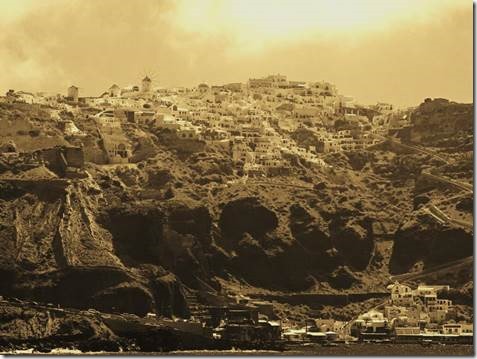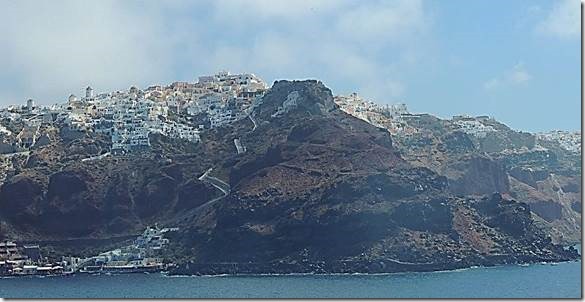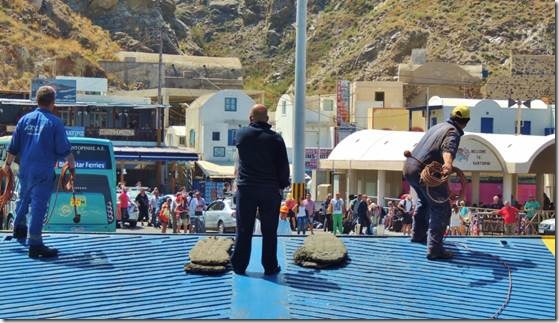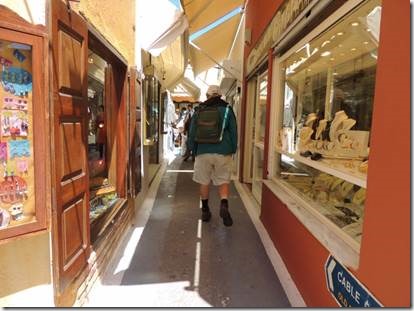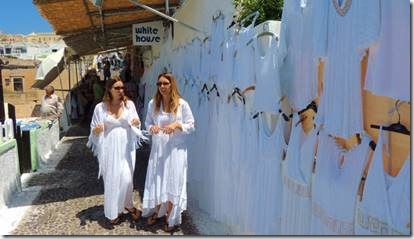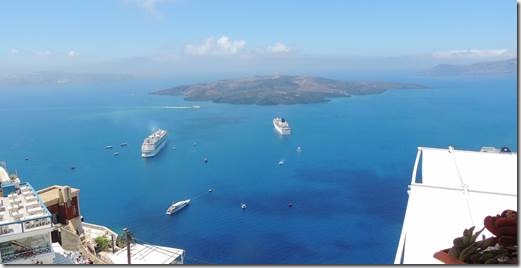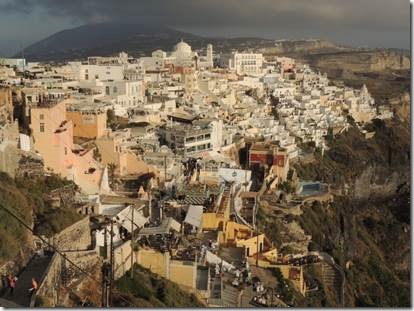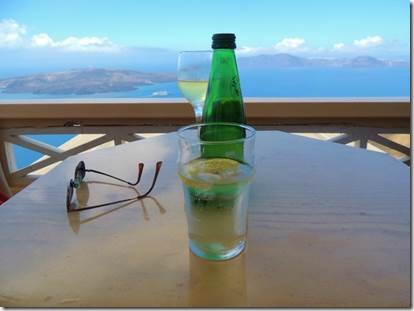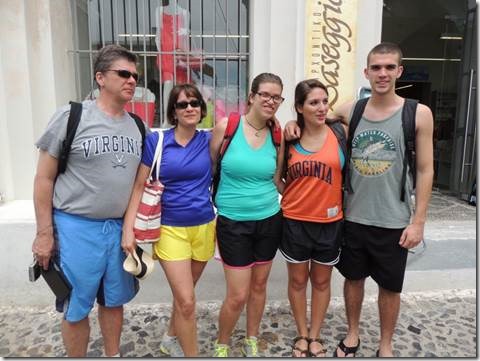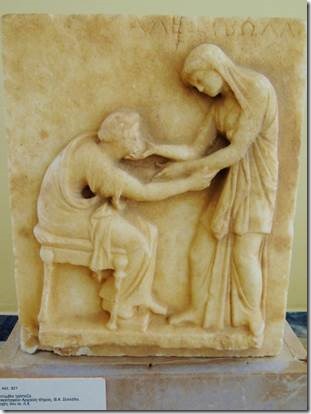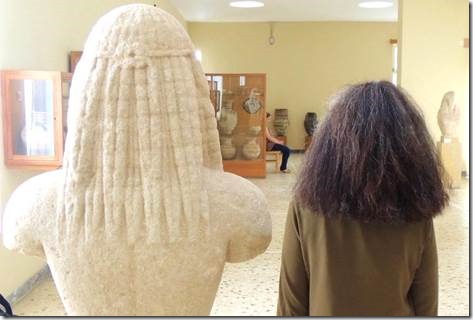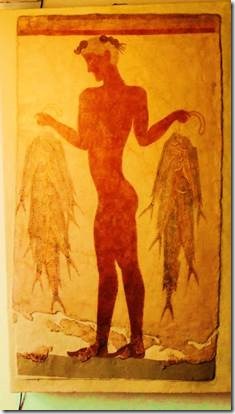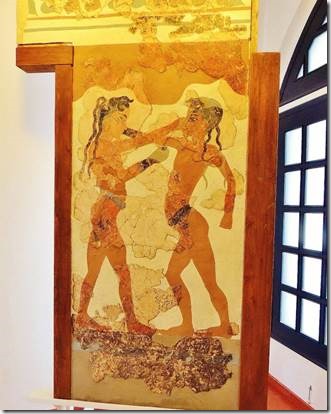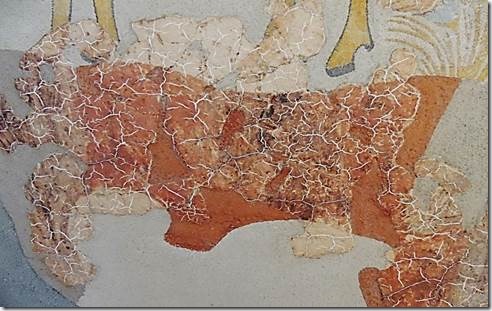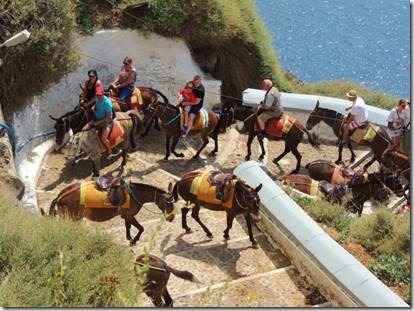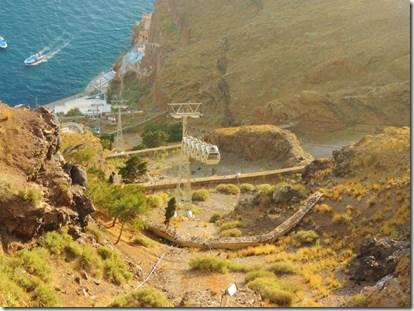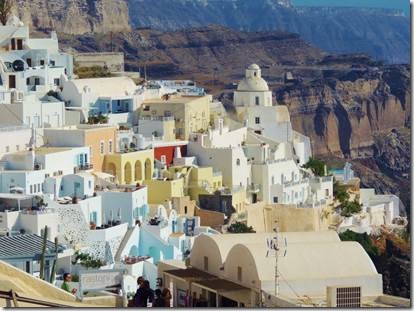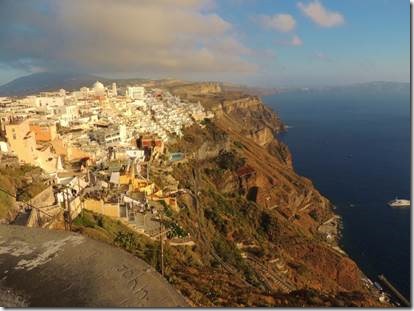Yasas,
This morning Randal and I rented a motorbike to tour the island. We climbed and climbed and climbed and came to Homer’s tomb. Maybe it’s really where he is buried or maybe not. Who is to say either way. Ios is a lovely island filled with terraced hillsides that Randal says indicates a much larger population once lived here. It would take that many people to build all of the terrace walls and to need all of the food those terraces would have produced. We saw the tame landscape on Nisyros. This afternoon we’ll bike back up the hill to Chora Village which really doesn’t come alive until 5 pm. I walked there yesterday, up the stone steps and it was a lovely walk around the very quiet town.
This email is about Santorini. I have an odd set of photos as you will see. The following Santorini email will show our catching the sunset show and our escape from the “café room hotel.”
Ru
For Randal ferrying into the caldera was probably the highlight of our trip to Santorini. For me it was my wonder around Fira actually finding my way back to the small beads shop I’d spied earlier in our day and then finding my way back to our “room under the café.” And watching the crowds gathered for sunset over the caldera was pretty fun too. But after the quiet charms of Simi, Nisyros, and here in Ios harbor, we really were quite overwhelmed with the hordes of tourists swarming over Santorini. At least 3 cruises ships were in the harbor at all times. That’s great for folks on those ships and we had a lovely chat with two semi-retired nurses from near New Castle, England who were from one ship. But it was too much hubbub for us and we stayed as short a time as ferry schedules would allow.
“Minor eruptions have been the norm in Greece’s earthquake record, but Santorini has bucked the trend – and with attitude – throughout history. Eruptions here were genuinely earth-shattering, and so wrenching that they changed the shape of the island several times.
Dorians, Venetians and Turks occupied Santorini, as they did all other Cycladic islands, but its most influential early inhabitants were Minoans. They came from Crete some time between 2000 and 1600 BC, and the settlement at Akrotiri dates from the peak years of their great civilisation.
The island was circular then and was called Strongili (Round One). In about 1650 BC a colossal volcanic eruption caused the centre of Strongili to sink, leaving a caldera with high cliffs – now one of the world’s most dramatic sights. Some archaeologists have speculated that this catastrophe destroyed not only Akrotiri but the structure, and eventually the essence, of Minoan civilisation
“Fantastic, fabulous Santorini deserves all the superlatives. Even the most jaded traveller succumbs to the awesome drama of this surreal landscape, relic of what was probably the biggest eruption in recorded history. That you share the experience with hordes of other visitors is inevitable. Embrace it all.
The caldera and its vast curtain wall of multicoloured cliffs is truly awesome. If you want to experience the full dramatic impact it’s worth arriving by a slower ferry with open decks, rather than by enclosed catamaran or hydrofoil.
Santorini is famous for its spectacular sunsets. The village of Oia on the northern tip of the island is a hugely popular sunset viewing site because there is an uninterrupted view of the sun as it finally sinks below the horizon. From farther south down the caldera edge, the last of the setting sun can be obscured by the islands of Nea Kameni and Thirasia. Take your pick, however. You can enjoy most of the sunset from almost anywhere along the rim of the caldera, especially if you want to avoid the sometimes feverish crush at Oia.
The main port, Athinios, stands on a cramped shelf of land at the base of Sphinxlike cliffs and is a scene of marvellous chaos that always seems to work itself out when ferries arrive. Buses (and taxis) meet all ferries and then cart passengers through an ever-rising series of S-bends to the capital, Fira, which fringes the edge of the cliffs like a snowy cornice”
http://www.lonelyplanet.com/greece/cyclades/santorini-thira
http://www.aboutsantorini.com/history.html more museum history
Our ferry from Ios was scheduled to leave 7:20 am. We left 9:30 am, that particular ferry line being not so “on time.” But it was smooth and short, about 80 minutes. Entering the caldera was exciting but the sunlight made photos hard to take. I turned this one sepia to show more details of one town up on the caldera’s hillside.
|
Ioa, the tip of the caldera, is Santorini’s Key West. |
|
Fira town where we stayed with the main harbor below and the hairpin turned road up. |
|
Throwing the lines at arrival in Fira where the whole street was lined with “tourist info/hotel/tour” kiosks and small cafes. One café hawker was an American by accent so I asked him for the bus to Fira town which we caught and sig- zagged our way up. |
|
There were a maze of streets that climbed up higher into Fira and all were lined with small shops selling the same things one to the next. |
|
Lots of cotton clothing for sale; these sisters were human mannequins. |
|
The island in the caldera and the cruise ships hovering in place. Water in the caldera was over 1,000 feet deep in places making anchoring for these cruise ships impossible. Instead of anchoring, cruise ships used their thrusters to hold them in position. Fuel is used to run the thrusters which seems pretty expensive and not great for the environment. Small tenders were used to ferry people back and forth between Santorini and the ships. |
|
Famous Santorini sight; Fira |
|
Another famous sight, sitting in a café overlooking the caldera having a drink. |
|
More colorful ingenious ways to wrap yourself up. |
|
Lots of Americans on the cruise ships; these were from Richmond. This photo was taken just as we were all about to enter the small antiquities museum filled with pottery and a few sculptures. We actually saw folks with B hats too, but my camera was in my pack and the narrow lane too crowded to make time for photos. |
|
From a cemetery of Ancient Thera (Fira) 3rd century BC. I loved the sentiment expressed in the image. |
|
Early 7th century BC and early 21st century. |
|
The boy with the fish is an image seen everywhere. “Painted about 1500 BC, these Minoan style murals are similar to those found at Knosos. The best known are The Young Fisherman depicting a youth holding blue and yellow fish and The Young Boxers, showing two young sparring partners with long black hair and almond shaped eyes. Preserved by lava, the frescoes have kept their colour and are displayed on a rotating basis at the New Archaelolgica Museum in Fira. Eyewitness Travel: The Greek Islands |
|
Photo enhanced to show the bits and fragments put together. I read in the museum information that green wasn’t a color found in the murals so maybe that’s why the fish were yellow and blue. But yellow and blue make green which was pointed out in the museum info so it’s an interesting question of why no green. I didn’t ask if photos were allowed and no sign said No Photos, but I didn’t use the flash so the colors aren’t so intense. We did watch a video showing how each of the zillion fragments was scanned three dimensionally and then put together like a puzzle rather than have to do it all by hand. Quite interesting. |
|
We opted for the bus, but one could ride a donkey part way up from the harbor. In the Philippines with our friend Carol we rode donkeys to a volcano caldera and Randal ended up walking half way. These donkeys looked more sturdy and the group of them could be smelled for a good distance. |
|
Or you could take cable cars. I wouldn’t so Randal didn’t though I guess he could have cabled up and I could have ridden up and that would have worked. |
|
More views of Fira |

